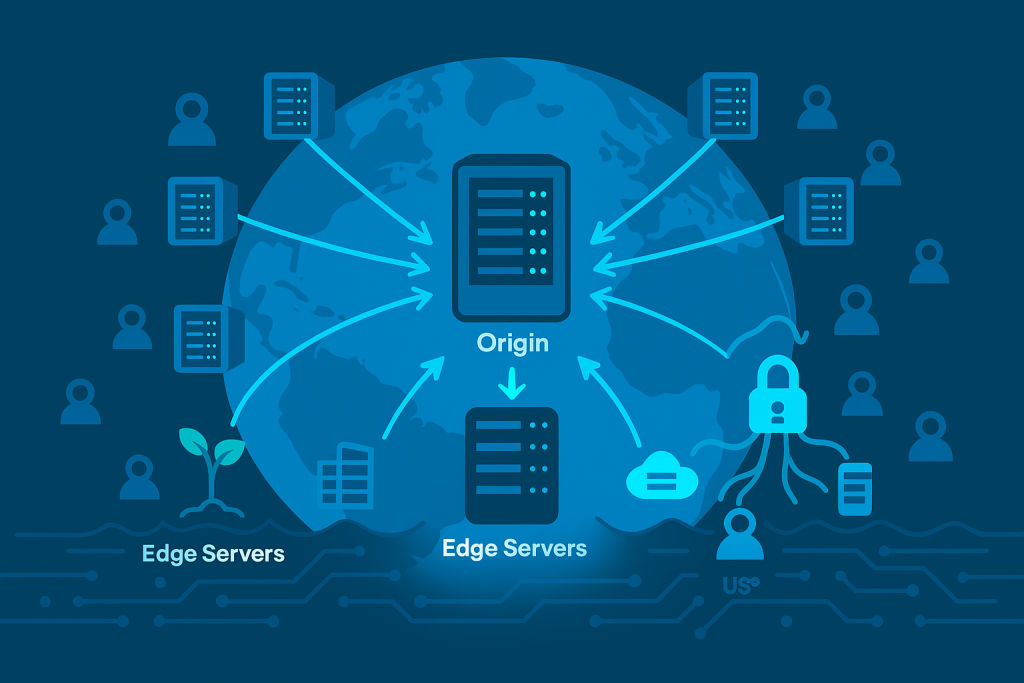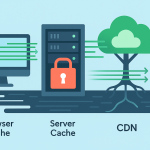Imagine you run a fantastic online bakery. Your recipes are famous, your photos are mouth-watering, and you have customers all over the world. Your website is hosted on a great server in New York City.
Now, imagine a customer in Sydney, Australia, wants to browse your new seasonal collection. When they click on your website, their computer has to send a request all the way to that single server in New York, which then has to send all the huge image files and code back across the ocean to Sydney.
That round trip—the physical distance the data has to travel—takes time. Even if it’s just a few seconds, those seconds feel like an eternity to the person waiting for your beautiful site to load.
This is the core difference between “No CDN” and the transformative power of a “CDN.”
In simple terms, a Content Delivery Network (CDN) is not just a technical upgrade; it’s a fundamental change in how your website operates on the global internet. It takes your single, distant server (your ‘Origin’) and turns it into a web of local servers around the world, making sure your content is never more than a short hop away from any user, no matter where they live.
If you want a fast, reliable, and secure website that can handle global traffic, understanding the deep mechanics of a CDN is non-negotiable. This is the expert-level guide to why the “no CDN” model is a relic of the past and how a CDN can be the single most powerful tool for boosting your website’s performance, SEO, and bottom line.
1. The Tale of Two Architectures: CDN vs. No CDN
To truly appreciate what a CDN does, we must first understand what the internet looks like without one.
The “No CDN” Model: The Single Point of Failure
Without a CDN, your website runs on what is called a single origin server.
Think of your origin server as the one and only central library for all your website’s data.
| Component | Description | Problem |
| Origin Server | The single computer storing all your files (HTML, CSS, images, videos, etc.) in one physical location (e.g., London). | All traffic must go here. If it fails, your entire website goes offline globally. |
| Latency | The delay (measured in milliseconds) caused by the physical distance data must travel from the server to the user. | A user in Tokyo accessing a server in London experiences high latency, resulting in slow load times. |
| Traffic Spike | A sudden, massive increase in visitors (e.g., a viral post or a Black Friday sale). | The single server gets overwhelmed. It becomes slow, unresponsive, or crashes entirely. This is called a DDoS vulnerability. |
| Bandwidth Cost | The cost you pay your host for the data (bandwidth) transferred from your server to users. | High, because your single server must transfer all data, all the time, to everyone. |
The Bottom Line (No CDN): While simple and low-cost for a tiny, local website, the “No CDN” model is fundamentally slow, fragile, and geographically unfair. It creates a terrible user experience for anyone not living close to your single server, directly damaging your conversion rate and search engine rankings.
The “CDN” Model: The Global Network of Speed
A Content Delivery Network is a globally distributed network of intermediary servers, known as Points of Presence (PoPs) or Edge Servers.
Instead of waiting for every request to travel to your one Origin server, the CDN places copies of your frequently accessed files (static assets like images, scripts, and CSS) on these PoPs all over the world.
Think of it this way: The CDN takes copies of your most popular books (images, videos) and distributes them to hundreds of local branch libraries (Edge Servers) worldwide.
| Component | Description | Benefit |
| Edge Servers (PoPs) | Servers strategically located in major cities across continents. | Serves content from the closest location, drastically reducing the physical distance and time data travels. |
| Caching | The process of temporarily storing copies of your files on the Edge Servers. | 80%+ of user requests are served from the local Edge Server, never touching your main Origin server. |
| Latency Reduction | The core speed benefit. The data only travels to the nearest PoP, not across the globe. | Time to First Byte (TTFB) is dramatically lowered, meaning the user sees the page start loading almost instantly. |
| Load Balancing | The CDN distributes traffic evenly across all its Edge Servers. | Prevents any single server (including your Origin) from being overwhelmed, ensuring stability during traffic spikes. |
The Bottom Line (CDN): The CDN transforms a geographically restricted, fragile website into a globally optimized, resilient, and blazing-fast delivery machine. It provides a consistent, high-speed experience to every user, everywhere.
2. Diving Deep: The Technical Transformation
The switch from No CDN to CDN is more than a speed bump; it’s a technical overhaul that impacts three key areas of website performance: Distance, Load, and Optimization.
A. The Latency Killer: Reducing Physical Distance
The single greatest enemy of website speed is Latency. In the digital world, data can only travel as fast as the speed of light. If your server is 5,000 miles away, it takes time for the request to go out and the data to come back.
- No CDN: A request from a user in Singapore to a server in Dallas, Texas, might involve 10-15 different network hops and a long physical distance, resulting in 250ms or more of latency before the content even starts loading.
- With CDN: The request is instantly routed to the nearest Edge Server in Singapore. This server already has a copy of the main image and CSS files. The data transfer distance is minimal, reducing latency to 10ms or 20ms. The user’s page starts rendering in a fraction of the time.
This reduction in the initial connection time (TTFB) is often the biggest speed improvement a website can make.
B. The Server Lifesaver: Offloading Your Origin
When you have no CDN, every single request—for every tiny image, every CSS file, every font—hits your Origin server. A high-traffic day is a huge stress test.
- No CDN: If you get 10,000 visitors, your single server must handle 10,000 simultaneous connections, fetching and sending out tens of thousands of files. This heavy workload leads to slow processing, connection timeouts, and server crashes.
- With CDN: When a user requests a page, the CDN immediately jumps in. It checks if the requested item (like a logo image or a JavaScript file) is in its local cache. In most cases (up to 80-90% of requests for static files), it is. The CDN serves the file, and your Origin server is never bothered. The CDN effectively absorbs the vast majority of your traffic load.
This offloading capability means your Origin server remains stable, responsive, and available for the one thing it must handle: generating the unique, non-cacheable parts of your page (like a personalized shopping cart or a logged-in user’s profile).
C. The Speed Enhancers: Built-in Optimizations
A top-tier CDN does more than just move files closer. It actively optimizes the files themselves as they are being delivered.
- Compression: CDNs automatically apply powerful compression algorithms (like Gzip or Brotli) to your HTML, CSS, and JavaScript files, making them physically smaller and faster to transmit.
- Minification: They can strip out unnecessary characters (like comments and white space) from your code, reducing the file size without changing the code’s function.
- Next-Generation Protocols: CDNs are pioneers in adopting the newest, fastest connection protocols, like HTTP/3 and QUIC. They manage these complex, secure connections, ensuring the data transfer channel is as optimized as possible, without you having to configure anything on your origin server.
3. The Unseen Impact: SEO, Conversions, and Security
The benefits of a CDN extend far beyond just technical speed scores. They directly influence the metrics that matter most to your business.
🚀 Performance and SEO: The Google Connection
Page speed is no longer optional; it’s a fundamental ranking factor. Google’s Core Web Vitals explicitly measure real-world user experience, and a CDN has a direct positive influence on all of them.
- LCP (Largest Contentful Paint): This measures how fast the largest element (usually an image or block of text) on your page loads. By serving large images from the closest Edge server, a CDN dramatically improves your LCP score.
- FID (First Input Delay) / INP (Interaction to Next Paint): These measure responsiveness. A faster-loading page requires less work from the user’s browser, freeing up its resources to respond quickly to clicks and taps, which boosts your interaction scores.
- Crawl Budget: Google’s bots have a limit (a “budget”) on how many pages they will crawl on your site in a given time. If your pages load slowly (No CDN), Google wastes time and might not crawl all your new content. With a fast CDN, Google’s bots can crawl and index your site much more efficiently. A faster site is a better-indexed site.
💰 Conversion and Revenue: The User Experience
Data consistently shows a direct correlation between page speed and sales.
- Reduced Bounce Rate: Studies show that a two-second delay can increase bounce rates by over 100%. A CDN provides the near-instantaneous loading required to keep users engaged and on your site.
- Increased Conversions: Amazon famously found that every 100ms of latency costs them 1% in sales. For an e-commerce site, a CDN is a revenue-protection tool, ensuring that your customers don’t abandon their shopping carts out of frustration.
- Global Reliability: For international businesses, a CDN ensures that your website performance is consistent in London, Lagos, and Los Angeles. You don’t lose sales simply because a customer lives on the other side of the world.
🛡️ Security: The First Line of Defense
A CDN acts as a powerful security shield, sitting between the public internet and your private Origin server.
- DDoS Mitigation: Because a CDN distributes traffic across hundreds of servers globally, it can absorb and filter massive volumes of malicious traffic from a Distributed Denial of Service (DDoS) attack before that traffic ever reaches your Origin server. It spreads the attack so thin that it becomes harmless.
- WAF (Web Application Firewall): Many premium CDNs include a WAF, which is an intelligent filter that blocks common web threats (like SQL injection and cross-site scripting) before they reach your code.
- SSL/TLS Management: CDNs simplify and accelerate the crucial SSL/TLS handshake process (the secure connection for HTTPS), making your site both secure and faster.
4. When Should You Go from “No CDN” to “CDN”?
The question is no longer if you need a CDN, but when you need one.
| Website Profile | Recommendation | The “Why” |
| Small, Local Website | Maybe Not Yet (But Consider Free Options) | If you only target one city or region, and have very low traffic, the speed gain might be minimal. However, many CDN providers offer fantastic free tiers (e.g., Cloudflare) that give you security and basic speed benefits at no cost. |
| Blog, Medium-Traffic Site | Absolutely Essential | Your content often goes viral or attracts international readers. A CDN is crucial for handling traffic spikes, reducing server load, and improving your Core Web Vitals for better SEO. |
| E-commerce Store | Non-Negotiable (Must-Have) | Every millisecond lost is money lost. Product images are large, and cart abandonment is high for slow sites. A CDN protects your revenue and ensures a smooth checkout process. |
| Media/Video Streaming | A Fundamental Component | Video files are massive. A CDN’s ability to efficiently serve large files globally is the only way to deliver high-quality, buffer-free media streams. |
The Modern Reality: With free and affordable entry-level CDN services widely available (like Cloudflare’s free plan), there is almost no legitimate reason for any serious or growing website to operate without a CDN today. The security, SEO, and user experience benefits far outweigh the minimal cost or setup time.
Conclusion: Stop Pushing, Start Distributing
The debate of CDN vs. No CDN is settled. If your website is anything more than a small, local brochure, adopting a Content Delivery Network is the most effective performance and security decision you can make.
- No CDN relies on distance, fragility, and high bandwidth costs.
- A CDN relies on proximity, resilience, and efficiency.
By distributing your content to the Edge, you are no longer forcing users to come to you; you are meeting them exactly where they are. You are turning a slow, single server into a high-speed, global content delivery system.
Make the switch, and watch your Core Web Vitals improve, your bounce rate drop, and your online business truly accelerate. The world is waiting, and with a CDN, you’ll be ready to greet them instantly.



